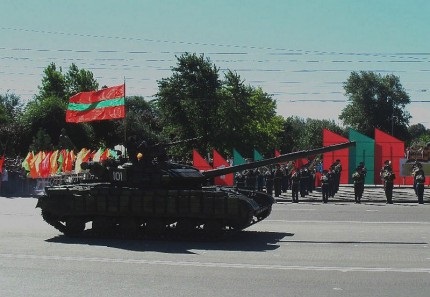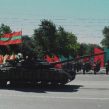
Russia’s Actions in Ukraine: Parallels with Other “Hot Spots” of the Former Soviet Union
Publication: Eurasia Daily Monitor Volume: 11 Issue: 126
By:

The conflict in eastern Ukraine has clear parallels with other “hot spots” in the former Soviet Union, where the Kremlin has ambitions. The clearest parallels are with the Transnistrian conflict on the eve of the collapse of the Soviet Union. Unlike the rest of Moldova, ethnic Moldovans in Transnistria constitute just 31.9 percent of the district’s population; the ethnic Russians are 30.4 percent and the ethnic Ukrainians—28.8 percent (Languages-study.com).
On August 31, 1989, the Supreme Soviet of the Moldavian Soviet Socialist Republic (MSSR) adopted a law proclaiming the Moldovan language as official, instead of Russian. Starting in September 1989, residents of Transnistria staged numerous demonstrations against the central government’s ethnic policies. On September 2, 1990, the Pridnestrovian Moldavian Soviet Socialist Republic was proclaimed by local Transnistrian deputies. Interestingly, the rhetoric of the Transnistrian separatists was very similar to the ideology and rhetoric of today’s separatists in eastern Ukraine. Secessionists in Transnistria claimed the threats of “Romanian fascism,” while the rebels in Ukraine are warning of the danger of “Bandera fascism.” The Moldovan separatists wanted their self-proclaimed republic to join the USSR; separatists in eastern Ukraine want to unite that part of the country with Russia (author’s interviews with Igor Smirnov, president of the “Pridnestrovian Moldavian Republic” in May 1991).
At the time of the war in Transnistria, the Moldovan media suspected that the Kremlin provoked Transnistrian separatism. That assumption was later supported by concrete evidence. For example, the USSR Supreme Soviet Chairman Anatoly Lukyanov told Moldova’s President Mircea Snegur in 1991: "If you want to get rid of separatism in Transnistria, sign the [New] Union Treaty” (Prism, June 27, 1997). In mid-1990s, it was revealed that Valery Lickai, the Transnistrian secretary of state and, in fact, the “main brain” behind the idea of a separatist republic, had been a KGB agent in Cuba from 1980 to 1982. In an interview he gave in the summer of 1996, Valery Lickai neither concealed his connections with the KGB nor Kremlin support for regional separatist movements in different parts of the USSR before its collapse in 1991 (including Transnistria).
In the same interview, he emphasized, however, that Kremlin’s support for various separatist movements might not be enough for achieving success in cases where enthusiasm for secession among ethnic minorities was not sufficiently strong. Lickai pointed to the Baltic states, where the Kremlin unsuccessfully attempted to initiate the separation of some areas with high-density Russian population in 1990–1991. However, separatist sentiment among the Russian population in the Baltics was lukewarm (rosbalt.ru, April 21; Author’s interview with Valeriy Lickai, June 1996).
While the separatist mood and anti-Chisinau feelings were very strong in Transnistria in the early 1990s (author’s interviews in Transnistria from May 1991 to June 1996), the level of support for separatism in eastern Ukraine appears to be much lower. According to an opinion poll conducted by ComRes for CNN, 37 percent of residents of the three eastern regions (Donetsk, Luhansk and Kharkiv) favor an alliance with Russia, while 14 percent back an alliance with the European Union and about a half (49 percent) say Ukraine would be better off, if it did not ally with either (CNN, May 14).
However, the relatively weak support for the separatists in eastern Ukraine is compensated by the involvement of Russian military volunteers. Such mercenaries actively participated in other military conflicts in the former Soviet Union. Numerous interviews conducted by the author in different conflict zones in the former Soviet Union in the 1990s, showed that there were two main types of Russian volunteers: the adventurists—many of whom have a criminal record—and extreme Russian nationalists. In addition, there were many former Soviet military servicemen in both groups. Since the “adventurists” are not overly disciplined, most field commanders were Russian nationalists. Today’s situation in Ukraine is very similar: many ordinary fighters are adventurists, but the rebel leaders are Russian nationalists. For example, the “commander-in-chief of the “Novorossiya” defense forces Igor Girkin (aka Strelkov) is a monarchist, or tsarist imperialist; Pavel Gubarev, the self-proclaimed “people’s governor of Donbas,” is a former member of the Russian National Unity (RNU)—an ultra-nationalist organization; Alexander Yurevich Borodai, the self-proclaimed prime minister of “Donetsk People’s Republic” is a commentator of the Russian far-right nationalist newspaper “Zavtra” and one of the founders of the nationalist Web TV Den-TV (Novaya Gazeta, June 16, Rosbalt, July 4).
There is no clear proof that during the Yeltsin administration Russian military volunteer formations abroad were the creations of the Kremlin. Moreover, most of these people had particularly negative sentiment toward the “pro-Western” Yeltsin government and many of them defended the Russian parliament against government troops in 1993. The volunteers often considered Boris Yeltsin as their enemy and “a traitor of the Russians” (author’s interview with Russian volunteers in Transnistria in 1992, Abkhazia in 1993 and Bosnia in 1995). The Kremlin could not trust these people, and so it is unlikely that, in such situations, the Russian volunteers were receiving direct orders from Moscow. However, the volunteers had connections with the Kremlin in “hot spots,” where Moscow continued the imperial line of the Soviet Union. For example, as was witnessed by the author in Abkhazia, the Russian defense ministry gave orders for accommodating Russian volunteers in a Russian military sanatorium there (Igor Rotar, Pylauschie Oblomki Imperiy. Moscow, Literaturnoe Obozrenie, 2001). In sum, cooperation between Moscow and Russian military volunteers during the Yeltsin era was relatively weak and Kremlin’s influence on the “soldiers of fortune” was not significant.
The situation dramatically changed when Vladimir Putin came to power. “Putin is absolute and irreplaceable,” according to philosopher Alexander Dugin, the best-known ideologist of the Russian nationalists and leader of the Eurasian Movement (Izvestia, October 5, 2007). The Georgian war in August 2008 was a clear illustration that Russia was ready to become directly involved in fighting a war in neighboring territories.
The union between Putin and the Russian nationalists became even stronger after the annexation of Crimea. For several months during Russia’s proxy war in eastern Ukraine, Kremlin rhetoric and that of the nationalists have been similar. Although some Russian nationalists consider it a betrayal that regular Russian troops did not invade eastern Ukraine, in reality, the Russian president is still recognized as their leader. “After taking Crimea, Putin started the revolution from the top. If we do not support Putin, then chaos will destroy him and the country. Changing the commander in chief during war is equal to treason,” wrote the commander of the “Donbas People’s militia,” Igor Girkin, in the social website Vkontakte (Vkontakte, June 22). This opinion is quite convenient for the Russian president, who could continue using the nationalists for his own interests.




